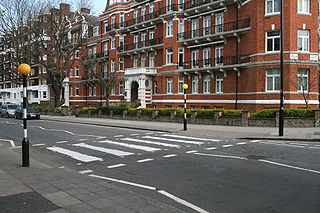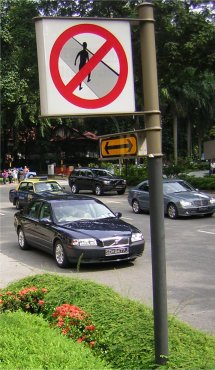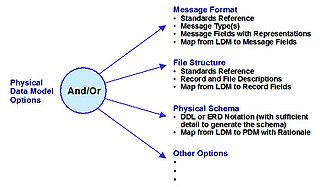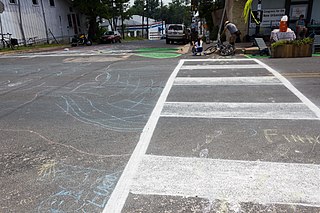
A zebra crossing or a marked crosswalk is a pedestrian crossing marked with white stripes. Normally, pedestrians are afforded precedence over vehicular traffic, although the significance of the markings may vary by jurisdiction. They are known as "zebra" crossings as the stripes resemble the coat of a zebra.

A pedestrian crossing is a place designated for pedestrians to cross a road, street or avenue. The term "pedestrian crossing" is also used in the Vienna and Geneva Conventions, both of which pertain to road signs and road traffic.

The database schema is the structure of a database described in a formal language supported typically by a relational database management system (RDBMS). The term "schema" refers to the organization of data as a blueprint of how the database is constructed. The formal definition of a database schema is a set of formulas (sentences) called integrity constraints imposed on a database. These integrity constraints ensure compatibility between parts of the schema. All constraints are expressible in the same language. A database can be considered a structure in realization of the database language. The states of a created conceptual schema are transformed into an explicit mapping, the database schema. This describes how real-world entities are modeled in the database.
In the context of SQL, data definition or data description language (DDL) is a syntax for creating and modifying database objects such as tables, indices, and users. DDL statements are similar to a computer programming language for defining data structures, especially database schemas. Common examples of DDL statements include CREATE, ALTER, and DROP.

Jaywalking is the act of pedestrians walking in or crossing a roadway if that act contravenes traffic regulations. The term originated in the United States as a derivation of the phrase jay-drivers, people who drove horse-drawn carriages and automobiles on the wrong side of the road, before taking its current meaning. Jaywalking was coined as the automobile arrived in the street in the context of the conflict between pedestrian and automobiles, more specifically the nascent automobile industry.

A physical data model is a representation of a data design as implemented, or intended to be implemented, in a database management system. In the lifecycle of a project it typically derives from a logical data model, though it may be reverse-engineered from a given database implementation. A complete physical data model will include all the database artifacts required to create relationships between tables or to achieve performance goals, such as indexes, constraint definitions, linking tables, partitioned tables or clusters. Analysts can usually use a physical data model to calculate storage estimates; it may include specific storage allocation details for a given database system.
A federated database system (FDBS) is a type of meta-database management system (DBMS), which transparently maps multiple autonomous database systems into a single federated database. The constituent databases are interconnected via a computer network and may be geographically decentralized. Since the constituent database systems remain autonomous, a federated database system is a contrastable alternative to the task of merging several disparate databases. A federated database, or virtual database, is a composite of all constituent databases in a federated database system. There is no actual data integration in the constituent disparate databases as a result of data federation.
The following tables compare general and technical information for a number of relational database management systems. Please see the individual products' articles for further information. Unless otherwise specified in footnotes, comparisons are based on the stable versions without any add-ons, extensions or external programs.
Boyce–Codd normal form is a normal form used in database normalization. It is a slightly stronger version of the third normal form (3NF). BCNF was developed in 1974 by Raymond F. Boyce and Edgar F. Codd to address certain types of anomalies not dealt with by 3NF as originally defined.
An entity–attribute–value model (EAV) is a data model optimized for the space-efficient storage of sparse—or ad-hoc—property or data values, intended for situations where runtime usage patterns are arbitrary, subject to user variation, or otherwise unforeseeable using a fixed design. The use-case targets applications which offer a large or rich system of defined property types, which are in turn appropriate to a wide set of entities, but where typically only a small, specific selection of these are instantiated for a given entity. Therefore, this type of data model relates to the mathematical notion of a sparse matrix. EAV is also known as object–attribute–value model, vertical database model, and open schema.
The Metadata Object Description Schema (MODS) is an XML-based bibliographic description schema developed by the United States Library of Congress' Network Development and Standards Office. MODS was designed as a compromise between the complexity of the MARC format used by libraries and the extreme simplicity of Dublin Core metadata.

An associative entity is a term used in relational and entity–relationship theory. A relational database requires the implementation of a base relation to resolve many-to-many relationships. A base relation representing this kind of entity is called, informally, an associative table.
In databases, relational schema may refer to
A schema crosswalk is a table that shows equivalent elements in more than one database schema. It maps the elements in one schema to the equivalent elements in another.

A HAWK beacon is a traffic control device used to stop road traffic and allow pedestrians to cross safely. It is officially known as a pedestrian hybrid beacon. The purpose of a HAWK beacon is to allow protected pedestrian crossings, stopping vehicular traffic only as needed. The HAWK beacon is a type of traffic control alternative to traffic control signals and/or where an intersection does not meet traffic signal warrants.
In databases, a synonym is an alias or alternate name for a table, view, sequence, or other schema object. They are used mainly to make it easy for users to access database objects owned by other users. They hide the underlying object's identity and make it harder for a malicious program or user to target the underlying object. Because a synonym is just an alternate name for an object, it requires no storage other than its definition. When an application uses a synonym, the DBMS forwards the request to the synonym's underlying base object. By coding your programs to use synonyms instead of database object names, you insulate yourself from any changes in the name, ownership, or object locations. If you frequently refer to a database object that has a long name, you might appreciate being able to refer to it with a shorter name without having to rename it and alter the code referring to it.

6½ Avenue is a north-south pedestrian passageway in Midtown Manhattan, New York City, running from West 51st to West 57th Streets between Sixth and Seventh Avenues.

A guerrilla crosswalk is a pedestrian crossing that has been modified or created without jurisdictional approval, and with the intent of improving pedestrian and other non-automobile safety. These interventions are a common strategy within tactical urbanism, a type of low-cost, often temporary change to the built environment intended to improve local livability. Guerilla crosswalks have been noted in news articles since at least 2009 and have become more well known as an urban strategy in recent years. The first known example of guerilla crosswalks can be found in Canada in 1987 when social activists John Valeriote and Erik Veldman created a crosswalk in Guelph, Ontario for students to safely cross a busy road in front of their school.







